SAAB 9-3 2009 Owners Manual
Manufacturer: SAAB, Model Year: 2009, Model line: 9-3, Model: SAAB 9-3 2009Pages: 304, PDF Size: 44.31 MB
Page 281 of 304
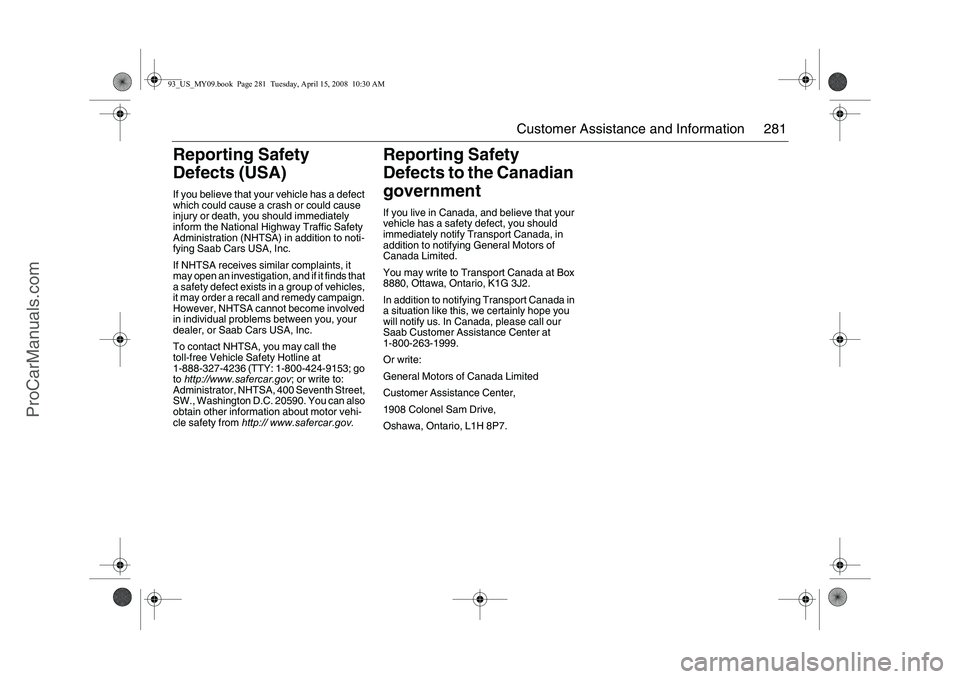
281 Customer Assistance and Information
Reporting Safety
Defects (USA)If you believe that your vehicle has a defect
which could cause a crash or could cause
injury or death, you should immediately
inform the National Highway Traffic Safety
Administration (NHTSA) in addition to noti-
fying Saab Cars USA, Inc.
If NHTSA receives similar complaints, it
may open an investigation, and if it finds that
a safety defect exists in a group of vehicles,
it may order a recall and remedy campaign.
However, NHTSA cannot become involved
in individual problems between you, your
dealer, or Saab Cars USA, Inc.
To contact NHTSA, you may call the
toll-free Vehicle Safety Hotline at
1-888-327-4236 (TTY: 1-800-424-9153; go
to http://www.safercar.gov; or write to:
Administrator, NHTSA, 400 Seventh Street,
SW., Washington D.C. 20590. You can also
obtain other information about motor vehi-
cle safety from http:// www.safercar.gov.
Reporting Safety
Defects to the Canadian
governmentIf you live in Canada, and believe that your
vehicle has a safety defect, you should
immediately notify Transport Canada, in
addition to notifying General Motors of
Canada Limited.
You may write to Transport Canada at Box
8880, Ottawa, Ontario, K1G 3J2.
In addition to notifying Transport Canada in
a situation like this, we certainly hope you
will notify us. In Canada, please call our
Saab Customer Assistance Center at
1-800-263-1999.
Or write:
General Motors of Canada Limited
Customer Assistance Center,
1908 Colonel Sam Drive,
Oshawa, Ontario, L1H 8P7.
93_US_MY09.book Page 281 Tuesday, April 15, 2008 10:30 AM
ProCarManuals.com
Page 282 of 304
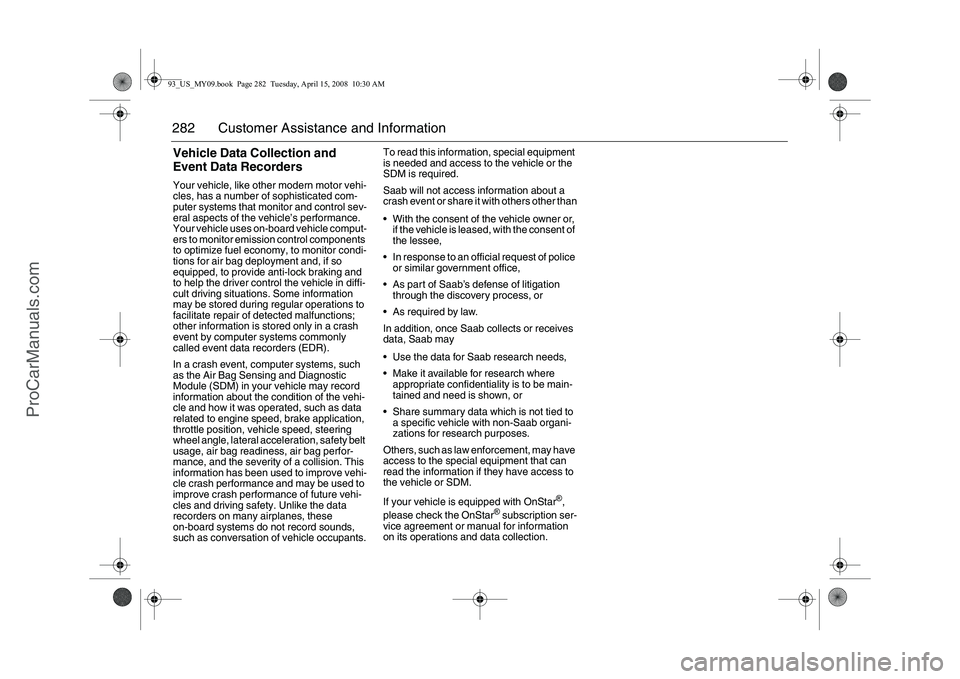
282 Customer Assistance and InformationVehicle Data Collection and
Event Data RecordersYour vehicle, like other modern motor vehi-
cles, has a number of sophisticated com-
puter systems that monitor and control sev-
eral aspects of the vehicle’s performance.
Your vehicle uses on-board vehicle comput-
ers to monitor emission control components
to optimize fuel economy, to monitor condi-
tions for air bag deployment and, if so
equipped, to provide anti-lock braking and
to help the driver control the vehicle in diffi-
cult driving situations. Some information
may be stored during regular operations to
facilitate repair of detected malfunctions;
other information is stored only in a crash
event by computer systems commonly
called event data recorders (EDR).
In a crash event, computer systems, such
as the Air Bag Sensing and Diagnostic
Module (SDM) in your vehicle may record
information about the condition of the vehi-
cle and how it was operated, such as data
related to engine speed, brake application,
throttle position, vehicle speed, steering
wheel angle, lateral acceleration, safety belt
usage, air bag readiness, air bag perfor-
mance, and the severity of a collision. This
information has been used to improve vehi-
cle crash performance and may be used to
improve crash performance of future vehi-
cles and driving safety. Unlike the data
recorders on many airplanes, these
on-board systems do not record sounds,
such as conversation of vehicle occupants.To read this information, special equipment
is needed and access to the vehicle or the
SDM is required.
Saab will not access information about a
crash event or share it with others other than
With the consent of the vehicle owner or,
if the vehicle is leased, with the consent of
the lessee,
In response to an official request of police
or similar government office,
As part of Saab’s defense of litigation
through the discovery process, or
As required by law.
In addition, once Saab collects or receives
data, Saab may
Use the data for Saab research needs,
Make it available for research where
appropriate confidentiality is to be main-
tained and need is shown, or
Share summary data which is not tied to
a specific vehicle with non-Saab organi-
zations for research purposes.
Others, such as law enforcement, may have
access to the special equipment that can
read the information if they have access to
the vehicle or SDM.
If your vehicle is equipped with OnStar
®,
please check the OnStar
® subscription ser-
vice agreement or manual for information
on its operations and data collection.
93_US_MY09.book Page 282 Tuesday, April 15, 2008 10:30 AM
ProCarManuals.com
Page 283 of 304
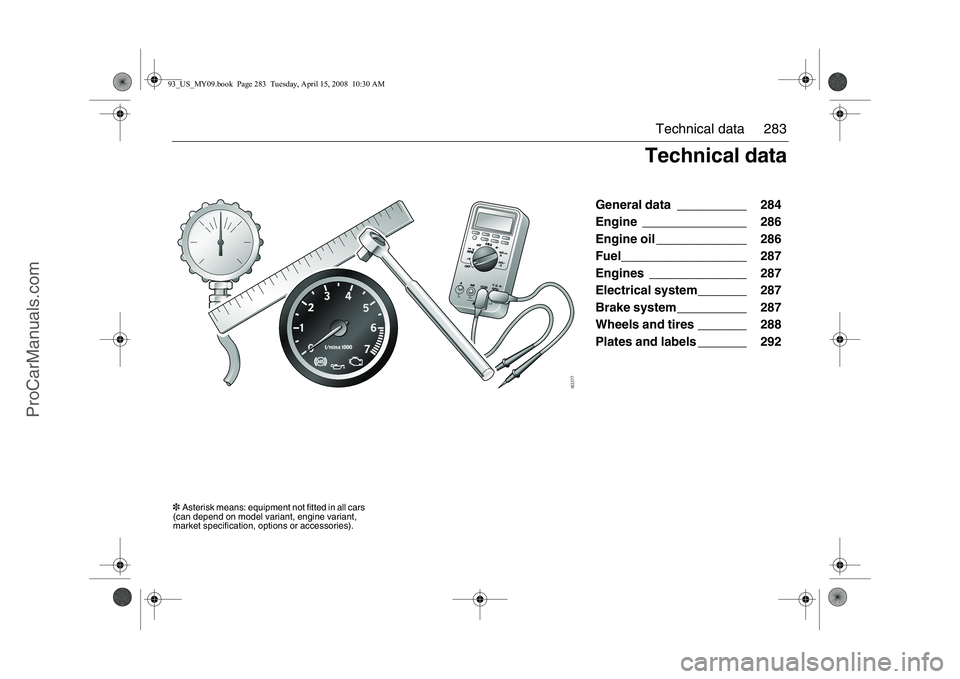
283 Technical data
General data __________ 284
Engine _______________ 286
Engine oil _____________ 286
Fuel__________________ 287
Engines ______________ 287
Electrical system_______ 287
Brake system__________ 287
Wheels and tires _______ 288
Plates and labels _______ 292
Technical data
3Asterisk means: equipment not fitted in all cars
(can depend on model variant, engine variant,
market specification, options or accessories).93_US_MY09.book Page 283 Tuesday, April 15, 2008 10:30 AM
ProCarManuals.com
Page 284 of 304
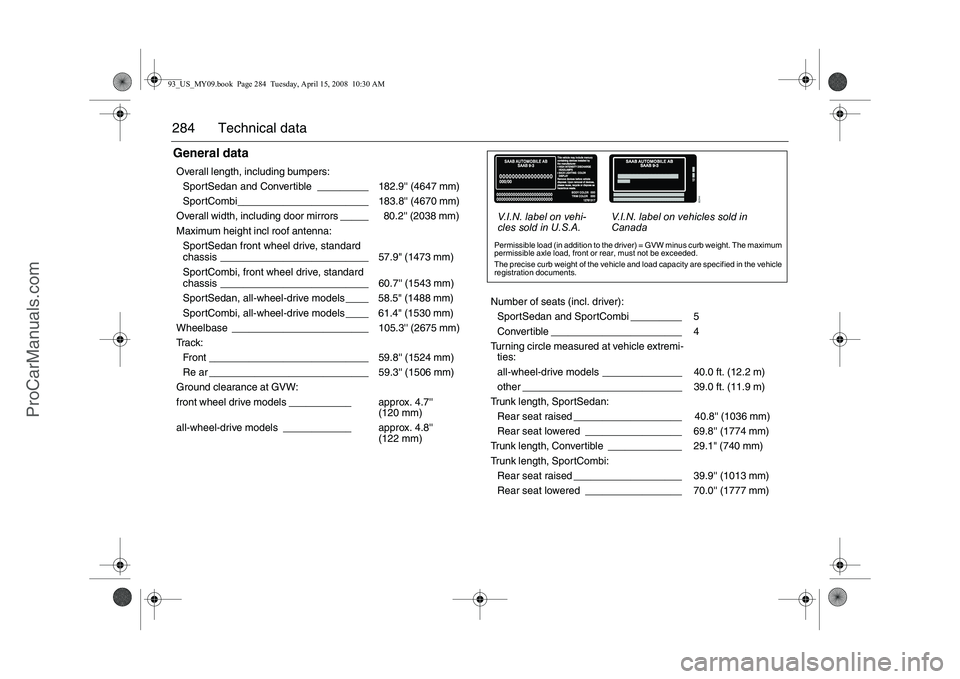
284 Technical dataGeneral dataOverall length, including bumpers:
SportSedan and Convertible _________ 182.9'' (4647 mm)
SportCombi_______________________ 183.8'' (4670 mm)
Overall width, including door mirrors _____ 80.2'' (2038 mm)
Maximum height incl roof antenna:
SportSedan front wheel drive, standard
chassis __________________________ 57.9" (1473 mm)
SportCombi, front wheel drive, standard
chassis __________________________ 60.7'' (1543 mm)
SportSedan, all-wheel-drive models ____ 58.5" (1488 mm)
SportCombi, all-wheel-drive models ____ 61.4" (1530 mm)
Wheelbase ________________________ 105.3'' (2675 mm)
Tr a c k :
Front ____________________________ 59.8'' (1524 mm)
Re ar ____________________________ 59.3'' (1506 mm)
Ground clearance at GVW:
front wheel drive models ___________ approx. 4.7''
(120 mm)
all-wheel-drive models ____________ approx. 4.8''
(122 mm)V.I.N. label on vehi-
cles sold in U.S.A.V.I.N. label on vehicles sold in
Canada
Permissible load (in addition to the driver) = GVW minus curb weight. The maximum
permissible axle load, front or rear, must not be exceeded.
The precise curb weight of the vehicle and load capacity are specified in the vehicle
registration documents.Number of seats (incl. driver):
SportSedan and SportCombi _________ 5
Convertible _______________________ 4
Turning circle measured at vehicle extremi-
ties:
all-wheel-drive models ______________ 40.0 ft. (12.2 m)
other ____________________________ 39.0 ft. (11.9 m)
Trunk length, SportSedan:
Rear seat raised ___________________ 40.8'' (1036 mm)
Rear seat lowered _________________ 69.8'' (1774 mm)
Trunk length, Convertible _____________ 29.1" (740 mm)
Trunk length, SportCombi:
Rear seat raised ___________________ 39.9'' (1013 mm)
Rear seat lowered _________________ 70.0'' (1777 mm)
93_US_MY09.book Page 284 Tuesday, April 15, 2008 10:30 AM
ProCarManuals.com
Page 285 of 304
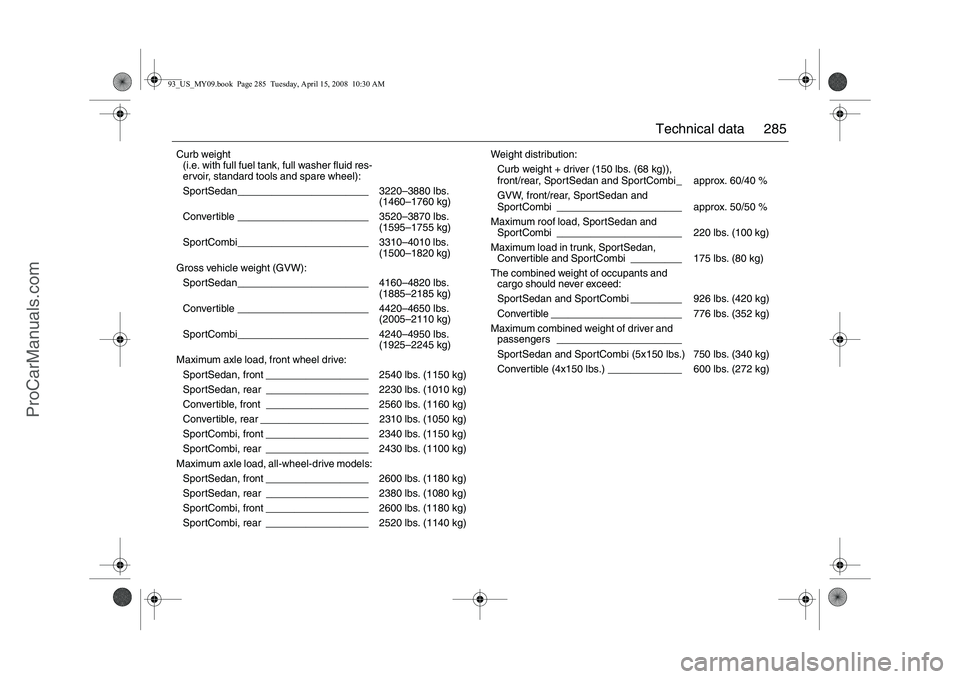
285 Technical data
Curb weight
(i.e. with full fuel tank, full washer fluid res-
ervoir, standard tools and spare wheel):
SportSedan_______________________ 3220–3880 lbs.
(1460–1760 kg)
Convertible _______________________ 3520–3870 lbs.
(1595–1755 kg)
SportCombi_______________________ 3310–4010 lbs.
(1500–1820 kg)
Gross vehicle weight (GVW):
SportSedan_______________________ 4160–4820 lbs.
(1885–2185 kg)
Convertible _______________________ 4420–4650 lbs.
(2005–2110 kg)
SportCombi_______________________ 4240–4950 lbs.
(1925–2245 kg)
Maximum axle load, front wheel drive:
SportSedan, front __________________ 2540 lbs. (1150 kg)
SportSedan, rear __________________ 2230 lbs. (1010 kg)
Convertible, front __________________ 2560 lbs. (1160 kg)
Convertible, rear ___________________ 2310 lbs. (1050 kg)
SportCombi, front __________________ 2340 lbs. (1150 kg)
SportCombi, rear __________________ 2430 lbs. (1100 kg)
Maximum axle load, all-wheel-drive models:
SportSedan, front __________________ 2600 lbs. (1180 kg)
SportSedan, rear __________________ 2380 lbs. (1080 kg)
SportCombi, front __________________ 2600 lbs. (1180 kg)
SportCombi, rear __________________ 2520 lbs. (1140 kg)Weight distribution:
Curb weight + driver (150 lbs. (68 kg)),
front/rear, SportSedan and SportCombi_ approx. 60/40 %
GVW, front/rear, SportSedan and
SportCombi ______________________ approx. 50/50 %
Maximum roof load, SportSedan and
SportCombi ______________________ 220 lbs. (100 kg)
Maximum load in trunk, SportSedan,
Convertible and SportCombi _________ 175 lbs. (80 kg)
The combined weight of occupants and
cargo should never exceed:
SportSedan and SportCombi _________ 926 lbs. (420 kg)
Convertible _______________________ 776 lbs. (352 kg)
Maximum combined weight of driver and
passengers ______________________
SportSedan and SportCombi (5x150 lbs.) 750 lbs. (340 kg)
Convertible (4x150 lbs.) _____________ 600 lbs. (272 kg)93_US_MY09.book Page 285 Tuesday, April 15, 2008 10:30 AM
ProCarManuals.com
Page 286 of 304
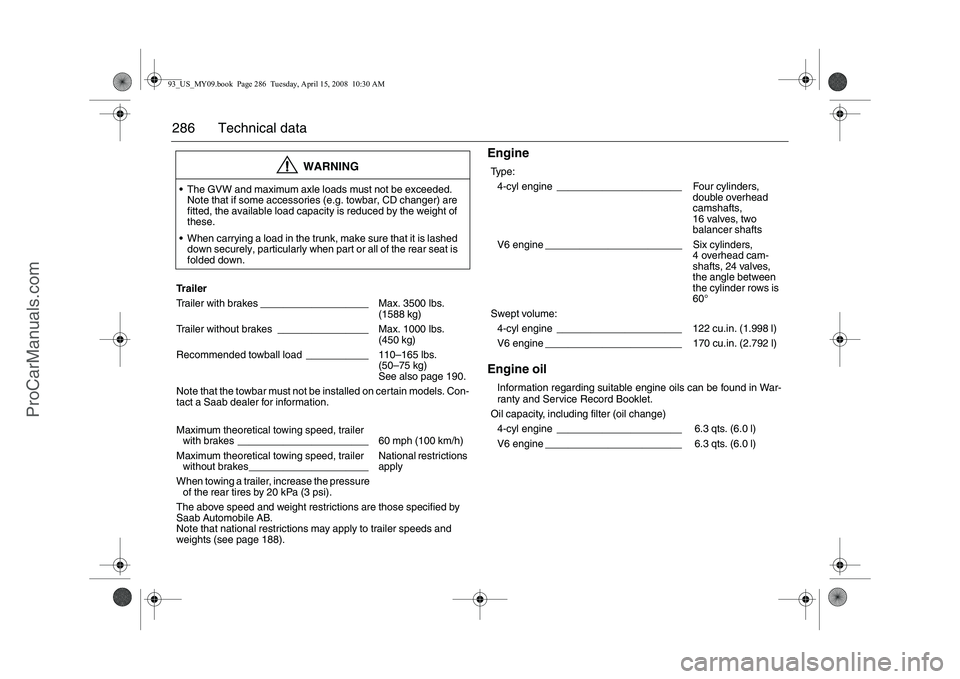
286 Technical data
Engine
Engine oil
WARNING
The GVW and maximum axle loads must not be exceeded.
Note that if some accessories (e.g. towbar, CD changer) are
fitted, the available load capacity is reduced by the weight of
these.
When carrying a load in the trunk, make sure that it is lashed
down securely, particularly when part or all of the rear seat is
folded down.
Trailer
Trailer with brakes ___________________ Max. 3500 lbs.
(1588 kg)
Trailer without brakes ________________ Max. 1000 lbs.
(450 kg)
Recommended towball load ___________ 110–165 lbs.
(50–75 kg)
See also page 190.
Note that the towbar must not be installed on certain models. Con-
tact a Saab dealer for information.
Maximum theoretical towing speed, trailer
with brakes _______________________ 60 mph (100 km/h)
Maximum theoretical towing speed, trailer
without brakes _____________________National restrictions
apply
When towing a trailer, increase the pressure
of the rear tires by 20 kPa (3 psi).
The above speed and weight restrictions are those specified by
Saab Automobile AB.
Note that national restrictions may apply to trailer speeds and
weights (see page 188).
Type:
4-cyl engine ______________________ Four cylinders,
double overhead
camshafts,
16 valves, two
balancer shafts
V6 engine ________________________ Six cylinders,
4 overhead cam-
shafts, 24 valves,
the angle between
the cylinder rows is
60°
Swept volume:
4-cyl engine ______________________ 122 cu.in. (1.998 l)
V6 engine ________________________ 170 cu.in. (2.792 l)
Information regarding suitable engine oils can be found in War-
ranty and Service Record Booklet.
Oil capacity, including filter (oil change)
4-cyl engine ______________________ 6.3 qts. (6.0 l)
V6 engine ________________________ 6.3 qts. (6.0 l)
93_US_MY09.book Page 286 Tuesday, April 15, 2008 10:30 AM
ProCarManuals.com
Page 287 of 304
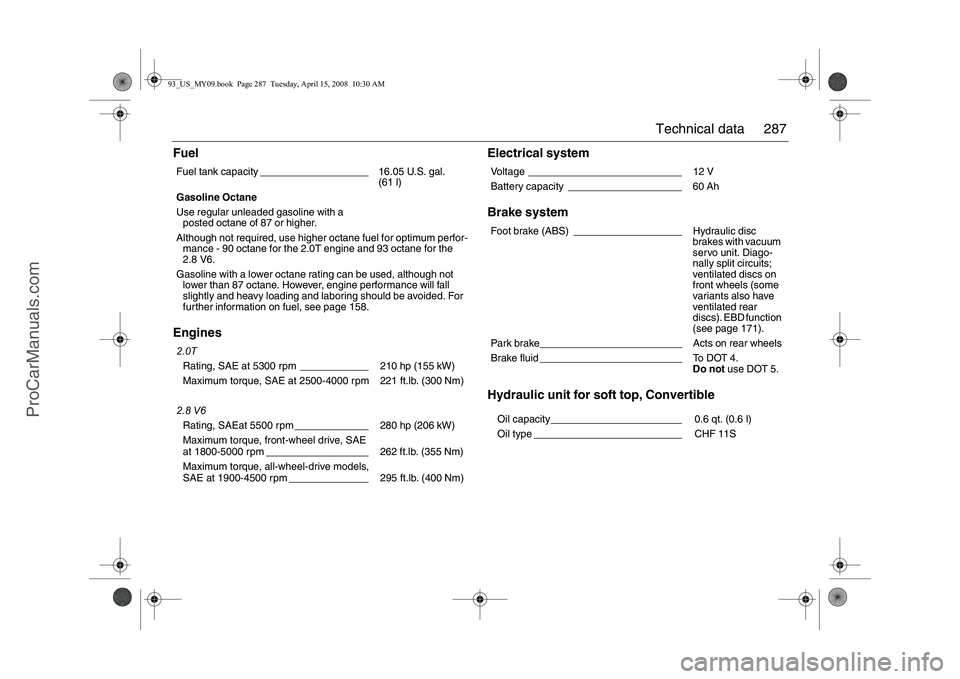
287 Technical data
Fuel
EnginesElectrical system
Brake system
Hydraulic unit for soft top, ConvertibleFuel tank capacity ___________________ 16.05 U.S. gal.
(61 l)
Gasoline Octane
Use regular unleaded gasoline with a
posted octane of 87 or higher.
Although not required, use higher octane fuel for optimum perfor-
mance - 90 octane for the 2.0T engine and 93 octane for the
2.8 V6.
Gasoline with a lower octane rating can be used, although not
lower than 87 octane. However, engine performance will fall
slightly and heavy loading and laboring should be avoided. For
further information on fuel, see page 158.
2.0T
Rating, SAE at 5300 rpm ____________ 210 hp (155 kW)
Maximum torque, SAE at 2500-4000 rpm 221 ft.lb. (300 Nm)
2.8 V6
Rating, SAEat 5500 rpm _____________ 280 hp (206 kW)
Maximum torque, front-wheel drive, SAE
at 1800-5000 rpm __________________ 262 ft.lb. (355 Nm)
Maximum torque, all-wheel-drive models,
SAE at 1900-4500 rpm ______________ 295 ft.lb. (400 Nm)Voltage ___________________________ 12 V
Battery capacity ____________________ 60 Ah
Foot brake (ABS) ___________________ Hydraulic disc
brakes with vacuum
servo unit. Diago-
nally split circuits;
ventilated discs on
front wheels (some
variants also have
ventilated rear
discs). EBD function
(see page 171).
Park brake_________________________ Acts on rear wheels
Brake fluid _________________________ To DOT 4.
Do not use DOT 5.
Oil capacity _______________________ 0.6 qt. (0.6 l)
Oil type __________________________ CHF 11S93_US_MY09.book Page 287 Tuesday, April 15, 2008 10:30 AM
ProCarManuals.com
Page 288 of 304
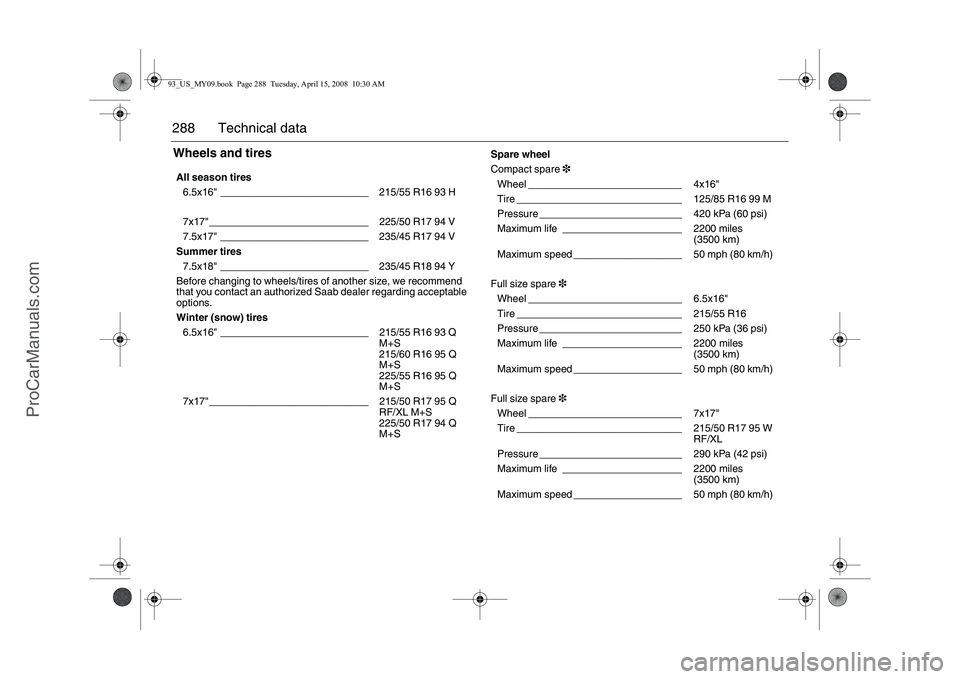
288 Technical dataWheels and tiresAll season tires
6.5x16" __________________________ 215/55 R16 93 H
7x17"____________________________ 225/50 R17 94 V
7.5x17" __________________________ 235/45 R17 94 V
Summer tires
7.5x18" __________________________ 235/45 R18 94 Y
Before changing to wheels/tires of another size, we recommend
that you contact an authorized Saab dealer regarding acceptable
options.
Winter (snow) tires
6.5x16" __________________________ 215/55 R16 93 Q
M+S
215/60 R16 95 Q
M+S
225/55 R16 95 Q
M+S
7x17"____________________________ 215/50 R17 95 Q
RF/XL M+S
225/50 R17 94 Q
M+SSpare wheel
Compact spare3
Wheel ___________________________ 4x16"
Tire _____________________________ 125/85 R16 99 M
Pressure _________________________ 420 kPa (60 psi)
Maximum life _____________________ 2200 miles
(3500 km)
Maximum speed ___________________ 50 mph (80 km/h)
Full size spare3
Wheel ___________________________ 6.5x16"
Tire _____________________________ 215/55 R16
Pressure _________________________ 250 kPa (36 psi)
Maximum life _____________________ 2200 miles
(3500 km)
Maximum speed ___________________ 50 mph (80 km/h)
Full size spare3
Wheel ___________________________ 7x17"
Tire _____________________________ 215/50 R17 95 W
RF/XL
Pressure _________________________ 290 kPa (42 psi)
Maximum life _____________________ 2200 miles
(3500 km)
Maximum speed ___________________ 50 mph (80 km/h)93_US_MY09.book Page 288 Tuesday, April 15, 2008 10:30 AM
ProCarManuals.com
Page 289 of 304
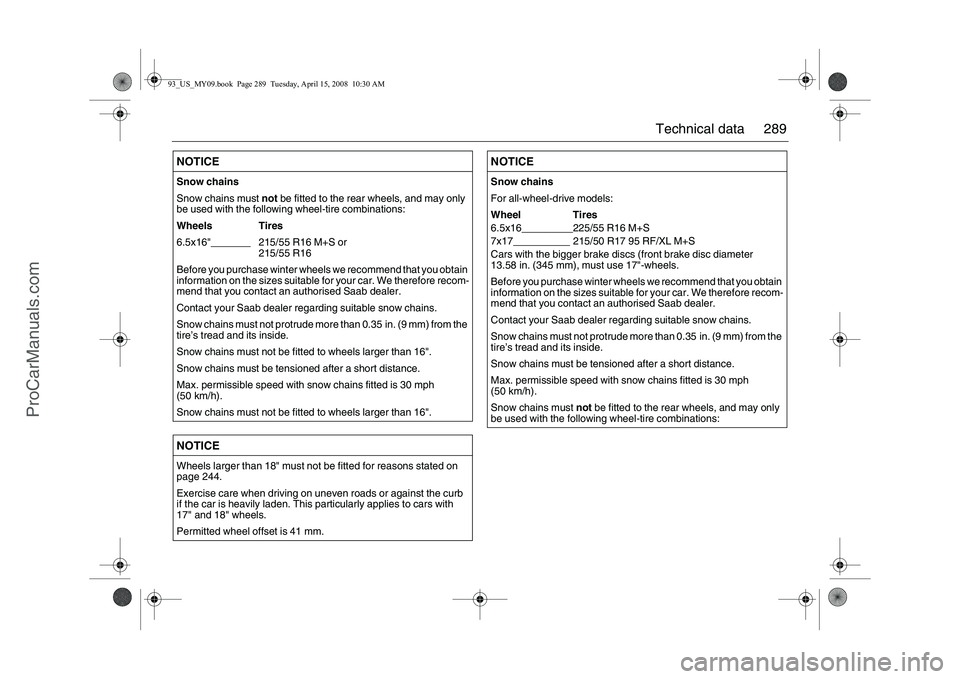
289 Technical data
NOTICESnow chains
Snow chains must not be fitted to the rear wheels, and may only
be used with the following wheel-tire combinations:
Wheels Tires
6.5x16"_______ 215/55 R16 M+S or
215/55 R16
Before you purchase winter wheels we recommend that you obtain
information on the sizes suitable for your car. We therefore recom-
mend that you contact an authorised Saab dealer.
Contact your Saab dealer regarding suitable snow chains.
Snow chains must not protrude more than 0.35 in. (9 mm) from the
tire’s tread and its inside.
Snow chains must not be fitted to wheels larger than 16".
Snow chains must be tensioned after a short distance.
Max. permissible speed with snow chains fitted is 30 mph
(50 km/h).
Snow chains must not be fitted to wheels larger than 16".NOTICEWheels larger than 18" must not be fitted for reasons stated on
page 244.
Exercise care when driving on uneven roads or against the curb
if the car is heavily laden. This particularly applies to cars with
17" and 18" wheels.
Permitted wheel offset is 41 mm.
NOTICESnow chains
For all-wheel-drive models:
Wheel Tires
6.5x16_________225/55 R16 M+S
7x17__________ 215/50 R17 95 RF/XL M+S
Cars with the bigger brake discs (front brake disc diameter
13.58 in. (345 mm), must use 17"-wheels.
Before you purchase winter wheels we recommend that you obtain
information on the sizes suitable for your car. We therefore recom-
mend that you contact an authorised Saab dealer.
Contact your Saab dealer regarding suitable snow chains.
Snow chains must not protrude more than 0.35 in. (9 mm) from the
tire’s tread and its inside.
Snow chains must be tensioned after a short distance.
Max. permissible speed with snow chains fitted is 30 mph
(50 km/h).
Snow chains must not be fitted to the rear wheels, and may only
be used with the following wheel-tire combinations:
93_US_MY09.book Page 289 Tuesday, April 15, 2008 10:30 AM
ProCarManuals.com
Page 290 of 304
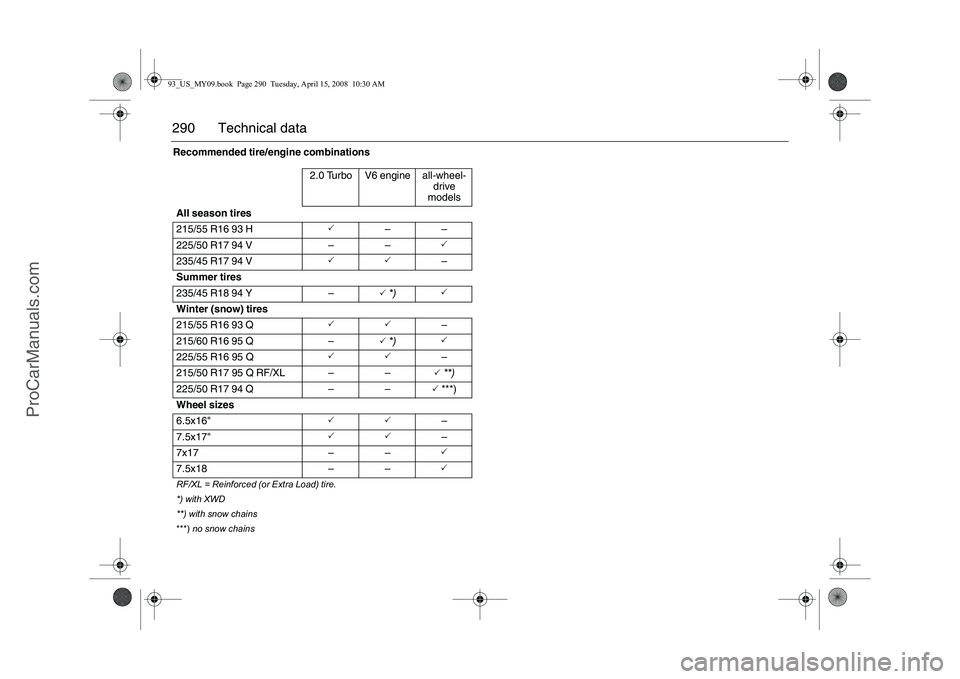
290 Technical dataRecommended tire/engine combinations
2.0 Turbo V6 engine all-wheel-
drive
models
All season tires
215/55 R16 93 H
�3
––
225/50 R17 94 V – –
�3
235/45 R17 94 V
�3�3
–
Summer tires
235/45 R18 94 Y –
�3 *)
�3
Winter (snow) tires
215/55 R16 93 Q
�3�3
–
215/60 R16 95 Q –
�3 *)
�3
225/55 R16 95 Q
�3�3
–
215/50 R17 95 Q RF/XL – –�3 **)
225/50 R17 94 Q – –�3 ***)
Wheel sizes
6.5x16"
�3�3
–
7.5x17"
�3�3
–
7x17 – –�3
7.5x18 – –
�3
RF/XL = Reinforced (or Extra Load) tire.
*) with XWD
**) with snow chains
***) no snow chains
93_US_MY09.book Page 290 Tuesday, April 15, 2008 10:30 AM
ProCarManuals.com